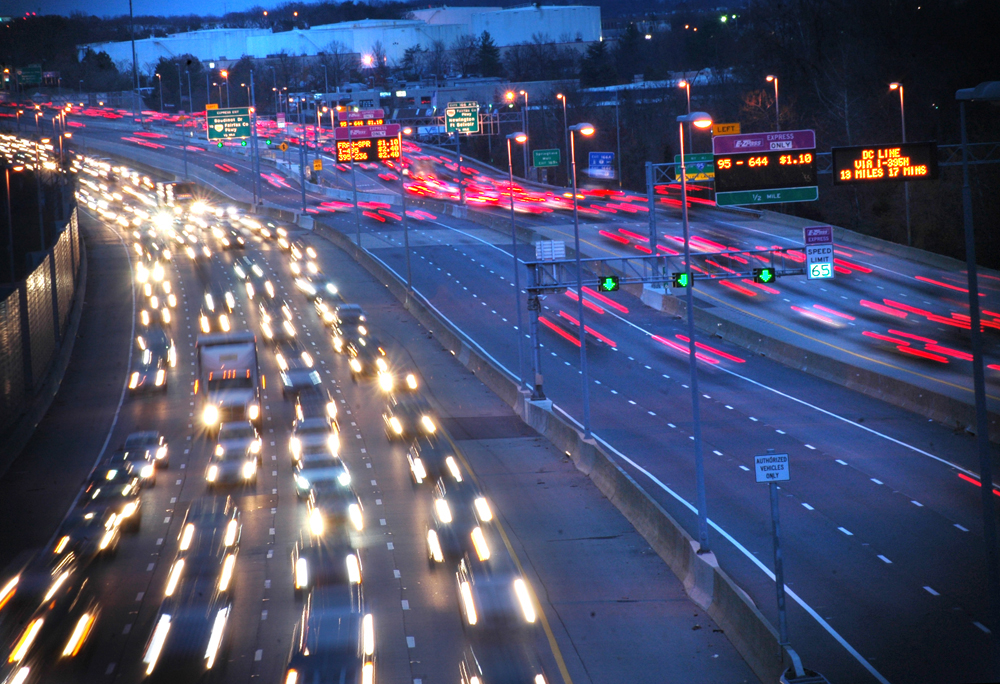
Revenue from toll lanes on the Capital Beltway and Interstate 95 in Virginia all but dried up in the spring, plummeting by nearly 90% compared to a year ago, as drivers stayed home amid widespread coronavirus restrictions.
That’s according to new figures revealed in a financial report to investors by Transurban, the Australian transportation company that manages and operates the toll lanes, which was published Wednesday.
Overall, toll revenue generated by the 495 Express Lanes fell to just $3 million in April, May and June. That’s down by 88% compared to the same time period last year, when the tolls took in $22 million.
The drop in revenue came amid a sharp decline in the number of drivers on D.C.-area roadways. The average number of trips on the I-495 Express Lanes in the spring tumbled by nearly 72% to 14,000 trips a day. Last year, over the same period, there were an average 49,000 trips a day on the toll lanes, which run along the Beltway in Virginia from Springfield to McLean.
On the I-95 Express Lanes, which run in Virginia from Stafford to Fairfax, toll revenue fell by slightly more — 89.5% — from $31 million last spring to $3 million this spring. The average number of trips on that stretch of toll lanes dropped from about 55,000 trips a day last spring to 19,000.
(Toll and traffic data for the I-395 Express Lanes was included in data for I-95.)
The plunge in traffic and toll revenues in April, May and June — the final three months of the 2020 fiscal year — was significant enough to drag annual toll revenue down by nearly 25% for the I-495 Express Lanes and by 19% on the I-95 Express Lanes.
The toll lanes are privately run by Transurban, and the loss in toll revenue is borne by the company, not Virginia taxpayers, said Transurban spokesman Mike McGurk.
“We, as the operators of this road, have to sort of bear that burden. So, you know, we are reeling with that impact, but that does not mean we are taking public money or that it’s a loss to public funds in that sense,” he said.
Similarly dramatic revenue losses were reported earlier this summer by the Virginia Department of Transportation, which collects tolls on I-66 inside the Beltway.
Between March and May of this year — the most recent data available — revenue generated by I-66 toll lanes fell by 90% and ridership plunged by about 64%, VDOT’s Michelle Holland told WTOP.
I-66 toll revenue is used to fund a host of Northern Virginia transportation projects.
More than a dozen projects — ranging from new entrances at the Ballston and McLean Metro stations to several Northern Virginia several bus routes — were seeking a total of about $25 million in funding from toll revenue, which is now up in the air because of the revenue losses and uncertainty stemming from the coronavirus pandemic.
The Northern Virginia Transportation Commission, which doles out the toll funding, voted in June to delay making decisions about which projects to fund until later this year.
Traffic in July still down 50%
Even as coronavirus restrictions have begun to ease, data released by Transurban show drivers haven’t yet returned in anything close to full force.
For July, the most recent month available, the average number of daily trips on the I-495 Express Lanes was still down 51% compared to last July. More drivers returned to I-95, where trips were down by 36% compared to last year.
That’s an improvement from April, when average daily trips had shrunk by 80%.
“The biggest impact we saw to our roads on the 495 and 95 Express Lanes really began at the onset of the restrictions and safety precautions that were put into place in late March and April,” McGurk said. “As we went into the spring and have continued into the summer, we’ve seen some of that traffic return back to the roads.”
Still, the company is bracing for a gradual recovery.
The financial report to investors released Wednesday said though the company is seeing signs of a gradual improvement as coronavirus restrictions have eased, recovery in the D.C. area “continues albeit at a slower rate, reflecting the prolonged government restrictions in the region.”
What does it mean for drivers?
Because the tolls on I-495 and I-95 use dynamic pricing, lower overall traffic volume has translated into cheaper tolls for the drivers — at least for those who are still on the roads.
Average toll prices on I-495 Express Lanes dipped below $2 in early April and $4 on the I-95 Express Lanes, according to an earlier investor report published in late June. In early March, before coronavirus restrictions, including when stay-at-home orders were issued across the region, the average toll prices were $5.40 and $8.70, respectively.
There are signs of a slow recovery there, too. By mid-June, average toll prices were ticking back up, reaching an average $5.60 on the I-95 Express Lanes and $2.50 on the I-495 Express Lanes.
The Transurban report lays out the clear financial impact of the coronavirus restrictions on the company, which operates toll lanes in the D.C. area; Montreal, Canada; and throughout Australia.
The decline in traffic on the company’s toll roads led to a total net loss at the company of about $110 million, according to the annual financial report.
The company does see signs of optimism. A survey commissioned by the company on “urban mobility trends from COVID-19” indicates people do plan to continue commuting to the office once the pandemic ends. The survey found 86% of respondents said they believe they will not significantly increase the amount of time they work from home once the pandemic ends.
“I think people in the D.C. region are hopeful to get back there on the roads … As that traffic increases throughout the region, that’s when folks really find the value of the Express Lanes in terms of getting that faster trip, shaving some time off their commute and getting a reliable commute,” McGurk said.
In the D.C. area, the company also points to a big potential business opportunity: building toll lanes along portions of the Capital Beltway and I-270 in Montgomery County, Maryland.
Transurban was one of four teams of private-sector companies shortlisted for the project, which is now in a public-comment review period.








